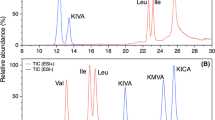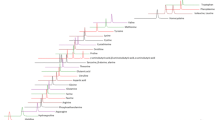Abstract
Glutaminolysis is the metabolic pathway that lyses glutamine to glutamate, alanine, citrate, aspartate, and so on. As partially recruiting reaction steps from the tricarboxylic acid (TCA) cycle and the malate-aspartate shuttle, glutaminolysis takes essential place in physiological and pathological situations. We herein developed a sensitive, rapid, and reproducible liquid chromatography-tandem mass spectrometry method to determine the perturbation of glutaminolysis in human plasma by quantifying 13 involved metabolites in a single 20-min run. A pHILIC column with a gradient elution system consisting of acetonitrile-5 mM ammonium acetate was used for separation, while an electrospray ionization source (ESI) operated in negative mode with multiple reaction monitoring was employed for detection. The method was fully validated according to FDA’s guidelines, and it generally provided good results in terms of linearity (the correlation coefficient no less than 0.9911 within the range of 0.05–800 μg/mL), intra- and inter-day precision (less than 18.38%) and accuracy (relative standard deviation between 89.24 and 113.4%), with lower limits of quantification between 0.05 and 10 μg/mL. The new analytical approach was successfully applied to analyze the plasma samples from 38 healthy volunteers and 34 patients with type 2 diabetes (T2D). Based on the great sensitivity and comprehensive capacity, the targeted analysis revealed the imperceptible abnormalities in the concentrations of key intermediates, such as iso-citrate and cis-aconitate, thus allowing us to obtain a thorough understanding of glutaminolysis disorder during T2D.

ᅟ




Similar content being viewed by others
References
Durán RV, Oppliger W, Robitaille AM, Heiserich L, Skendaj R, Gottlieb E, et al. Glutaminolysis activates Rag-mTORC1 signaling. Mol Cell. 2012;47(3):349–58.
Le A, Lane AN, Hamaker M, Bose S, Gouw A, Barbi J, et al. Glucose-independent glutamine metabolism via TCA cycling for proliferation and survival in b cells. Cell Metab. 2012;15(1):110–21.
Altman BJ, Stine ZE, Dang CV. From Krebs to clinic: glutamine metabolism to cancer therapy. Nat Rev Cancer. 2016;16:619–34.
Jin L, Alesi GN, Kang S. Glutaminolysis as a target for cancer therapy. Oncogene. 2015;35(28):3619–25.
Villar VH, Nguyen TL, Delcroix V, Terés S, Bouchecareilh M, Salin B, et al. mTORC1 inhibition in cancer cells protects from glutaminolysis-mediated apoptosis during nutrient limitation. Nat Commun. 2017;8:14124.
Wise DR, Thompson CB. Glutamine addiction: a new therapeutic target in cancer. Trends Biochem Sci. 2011;35(8):427–33.
Dang CV. Glutaminolysis: supplying carbon or nitrogen or both for cancer cells? Cell Cycle. 2010;9(19):3884–6.
Jacque N, Ronchetti AM, Larrue C, Meunier G, Birsen R, Willems L, et al. Targeting glutaminolysis has antileukemic activity in acute myeloid leukemia and synergizes with BCL-2 inhibition. Blood. 2015;126(11):1346–56.
Kelly A, Li C, Gao Z, Stanley CA, Matschinsky FM. Glutaminolysis and insulin secretion from bedside to bench and back. Diabetes. 2002;51((suppl3)(6)):S421–6.
Xu F, Tavintharan S, Sum CF, Woon K, Lim SC, Ong CN. Metabolic signature shift in type 2 diabetes mellitus revealed by mass spectrometry-based metabolomics. J Clin Endocrinol Metab. 2013;98(6):1060–5.
Zhang AH, Sun H, Yan GL, Yuan Y, Han Y, Wang XJ. Metabolomics study of type 2 diabetes using ultra-performance LC-ESI/quadrupole-TOF high-definition MS coupled with pattern recognition methods. J Physiol Biochem. 2014;70(1):117–28.
Siegel D, Permentier H, Reijngoud DJ, Bischoff R. Chemical and technical challenges in the analysis of central carbon metabolites by liquid-chromatography mass spectrometry. J Chromatogr B Anal Technol Biomed Life Sci. 2014;966:21–33.
Jung JY, Oh MK. Isotope labeling pattern study of central carbon metabolites using GC/MS. J Chromatogr B Anal Technol Biomed Life Sci. 2015;974:101–8.
Nemkov T, Hansen KC, D’Alessandro A. A three-minute method for high-throughput quantitative metabolomics and quantitative tracing experiments of central carbon and nitrogen pathways. Rapid Commun Mass Spectrom. 2017;31(8):663–73.
Hur H, Paik MJ, Xuan Y, Nguyen DT, Ham IH, Yun J, et al. Quantitative measurement of organic acids in tissues from gastric cancer patients indicates increased glucose metabolism in gastric cancer. PLoS One. 2014;9(6):1–9.
Calderón-Santiago M, Priego-Capote F, Galache-Osuna JG, Luque de Castro MD. Method based on GC-MS to study the influence of tricarboxylic acid cycle metabolites on cardiovascular risk factors. J Pharm Biomed Anal. 2013;74:178–85.
Hnatyshyn S, Shipkova P. Automated and unbiased analysis of LC-MS metabolomic data. Bioanalysis. 2012;4(5):541–54.
Al Kadhi O, Melchini A, Mithen R, Saha S. Development of a LC-MS/MS method for the simultaneous detection of tricarboxylic acid cycle intermediates in a range of biological matrices. J Anal Methods Chem. 2017;2017(5391832):1–12.
Michopoulos F, Whalley N, Theodoridis G, Wilson ID, Dunkley TPJ, Critchlow SE. Targeted profiling of polar intracellular metabolites using ion-pair-high performance liquid chromatography and -ultra high performance liquid chromatography coupled to tandem mass spectrometry: applications to serum, urine and tissue extracts. J Chromatogr A. 2014;1349:60–8.
Luo B, Groenke K, Takors R, Wandrey C, Oldiges M. Simultaneous determination of multiple intracellular metabolites in glycolysis, pentose phosphate pathway and tricarboxylic acid cycle by liquid chromatography-mass spectrometry. J Chromatogr A. 2007;1147:153–64.
Han J, Gagnon S, Eckle T, Borchers CH. Metabolomic analysis of key central carbon metabolism carboxylic acids as their 3-nitrophenylhydrazones by UPLC/ESI-MS. Electrophoresis. 2013;34(19):2891–900.
González O, Blanco ME, Iriarte G, Bartolomé L, Maguregui MI, Alonso RM. Bioanalytical chromatographic method validation according to current regulations, with a special focus on the non-well defined parameters limit of quantification, robustness and matrix effect. J Chromatogr A. 2014;1353:10–27.
Buszewski B, Noga S. Hydrophilic interaction liquid chromatography (HILIC)-a powerful separation technique. Anal Bioanal Chem. 2012;402(1):231–47.
Fernández-Fernández R, López-Martínez JC, Romero-González R, Martínez-Vidal JL, Alarcón Flores MI, Garrido Frenich A. Simple LC–MS determination of citric and malic acids in fruits and vegetables. Chromatographia. 2010;72(1–2):55–62.
Wang P, Mai C, Wei Y, Zhao J, Hu Y, Zeng Z, et al. Decreased expression of the mitochondrial metabolic enzyme aconitase (ACO2) is associated with poor prognosis in gastric cancer. Med Oncol. 2013;30(552):1–9.
Gumieniczek A, Komsta Ł, Chehab MR. Effects of two oral antidiabetics, pioglitazone and repaglinide, on aconitase inactivation, inflammation and oxidative/nitrosative stress in tissues under alloxan-induced hyperglycemia. Eur J Pharmacol. 2011;659(1):89–93.
Bajad SU, Lu W, Kimball EH, Yuan J, Peterson C, Rabinowitz JD. Separation and quantitation of water soluble cellular metabolites by hydrophilic interaction chromatography-tandem mass spectrometry. J Chromatogr A. 2006;1125(1):76–88.
Fiori J, Amadesi E, Fanelli F, Tropeano CV, Rugolo M, Gotti R. Cellular and mitochondrial determination of low molecular mass organic acids by LC-MS/MS. J Pharm Biomed Anal. 2017;150:33–8.
Acknowledgments
The authors would like to thank the subjects for their participation.
Funding
This study was financially supported by the National Natural Science Foundation of China (No. 81403181), the Natural Science Foundation of Heilongjiang Province of China (No. QC2016109), and the Open Project Program of the MOE Key Laboratory of Drug Quality Control and Pharmacovigilance (China Pharmaceutical University) (No. DQCP2017MS02).
Author information
Authors and Affiliations
Corresponding authors
Ethics declarations
Conflict of interest
The authors declare that they have no conflict of interest.
Ethical approval
All procedures performed in studies involving human participants were following the ethical standards of the institutional and/or national research committee and with the 1964 Helsinki declaration and its later amendments or comparable ethical standards.
Informed consent
Informed consent was obtained from the individual participants who provided the blood samples.
Additional information
Publisher’s note
Springer Nature remains neutral with regard to jurisdictional claims in published maps and institutional affiliations.
Electronic supplementary material
ESM 1
(PDF 954 kb)
Rights and permissions
About this article
Cite this article
Hua, Y., Yang, X., Li, R. et al. Quantitative characterization of glutaminolysis in human plasma using liquid chromatography-tandem mass spectrometry. Anal Bioanal Chem 411, 2045–2055 (2019). https://doi.org/10.1007/s00216-019-01626-3
Received:
Revised:
Accepted:
Published:
Issue Date:
DOI: https://doi.org/10.1007/s00216-019-01626-3




